Exercises play an important role in the treatment of Frozen Shoulder. In fact, all joint and musculoskeletal diseases require some form of physiotherapy and exercise for pain relief and restoring joint function.
Frozen Shoulder is commonly called Adhesive Capsulitis. It is characterized by the development of thick adhesions, capsular thickening, and capsular restrictions.
It is important to know that the shoulder joint is a ball and socket joint consisting of three bones contributing to the formation of this joint.
- Humerus
- Clavicle
- Scapula

There is a dense connective tissue that surrounds the whole joint responsible for interconnecting these structures together, which is known as the shoulder capsule.
Find Pills to Boost your Health Naturally
| You may also like to read: |
How does the shoulder get Jammed or frozen?
When you develop a frozen shoulder, this capsule gets hard and tight thus restricting the mobility of joints. It gradually results in scar formation resulting in the decreased quantity of joint fluid known as synovial fluid, because of decreased production of synovial fluid joint lubrication is compromised thus the joint gets jammed.
This condition is most commonly characterized by decreased shoulder joint mobility, flexibility, and increased stiffness.
It’s not caused by arthritic changes of bone and cartilage as we see in osteoarthritis and rheumatoid arthritis.
Arthritis can usually affect any joint of the body but this condition specifically involves the shoulder joint.
| You may also like to read: |
The onset of disease:
The onset is insidious but usually occurs between the age of 40 & 60 years. It is most common in women than men.
What causes a Frozen Shoulder?
One of the most common causes of a frozen shoulder is immobility, which can occur while recovering from a shoulder injury, broken arm, or stroke.
There are many other causes that contribute to this problem:
- Prolonged immobilization
- Rheumatoid arthritis
- Osteoarthritis
- Severe trauma
- Patients having surgery like mastectomy
- Stroke
- Diabetes mellitus
- Hypertension
- Cardiovascular diseases
- Parkinson’s disease
- Thyroid disease
- Inflammation in muscles or soft tissues
- Faulty posture
- Muscle weakness
- Overuse syndromes
| You may also like to read: |
Clinical Signs And Symptoms of Frozen Shoulder (Adhesive Capsulitis):
The major symptoms of a frozen shoulder are pain and stiffness. If you have a frozen shoulder, you will probably feel a dull pain in your shoulder.
You may also feel pain in the shoulder muscles that surround your upper arm. Your pain may get worse at night, which can make it difficult to sleep.
You will usually go through three phases with a frozen shoulder. Each has its own symptoms and onset of pain.
Acute Phase of adhesive capsulitis:
This is the initial stage in which pain and muscle stiffness limit the mobility of joints. Pain is often experienced at the shoulder joint radiating to the elbow.
This pain may often disturb your sleep. There is no joint swelling in this phase, although you can feel tenderness on palpation.
Subacute Phase of adhesive capsulitis:
Capsular tightness begins to develop in this phase. Joint Mobility is limited. You’ll often feel pain at the end of the limited range.
In this phase patient can be treated as the acute condition begins to subside by gradually increasing the shoulder motion and activity, in this way the complication of joint and soft tissue contractures can be minimized.
Chronic Phase of adhesive capsulitis:
In this stage, progressive restriction of the shoulder joint is observed thus resulting in limited motion of the joint.
There is a significant loss of joint activity in this stage so you may not be able to perform overhead activities, outward motions & movements behind the back.
| You may also like to read: |
The 4 Stages Of Frozen Shoulder:
There are clinically four stages of a frozen shoulder, so it’s important to do a self-assessment by thoroughly reading this to be fully aware of the severity of your problem,
Stage 1
This stage is usually characterized by
- Gradual onset of pain that increases with movements and is usually present at night.
- Loss of external rotation movement is commonly observed.
- The duration of this stage is usually less than 3 months.
Stage 2 (Freezing Stage)
This stage is usually characterized by:
- Constant and severe pain even at rest.
- Movement is restricted in all directions.
- The movement can’t be fully restored with intra-articular injection.
- The duration of this stage is typically between 3 to 9 months.
Stage 3 (Frozen Stage)
This stage is usually characterized by:
- Having pain only during movements accompanied by adhesion formations.
- You’ll feel substitute motions in the scapula.
- Atrophy of Muscles surrounding the shoulder joint is observed.
- The duration of this stage is typically between 9-15 months.
Stage 4 (Thawing Stage)
This stage is usually characterized by
- Minimal pain and no inflammation are observed in the joint.
- Maximum capsular restrictions and adhesions develop.
- However, the motion may gradually improve during this stage.
- This stage may last from 15 to 24 months or longer than this.
| You may also like to read: |
Activity Limitations in Patients with Frozen Shoulders:
- Night pain and disturbed sleep
- Pain on movement and often at rest
- Decreased joint motion
- Faulty postures to compensate for movements
- Decreased arm swing during gait
- General muscle weakness
- Inability to reach overhead, behind the head, behind the back, or outside.
- Difficulty dressing, reaching hands into the back pocket of pants, reaching out a car window, combing, brushing teeth, washing face, eating, or drinking.
- Difficulty lifting heavyweight
| You may also like to read: |
Physiotherapy Treatment of Frozen Shoulder:
The doctor will test the range of motion of the arm and may advise an x-ray to find out any underlying condition. Treatment is aimed at relieving the pain and restoring movement and function of the shoulder joint.
Treatment includes:
Drugs (such as aspirin or ibuprofen) to reduce inflammation and relieve pain.
- Mobility exercises
- Heat or ice therapy.
- Corticosteroid injections (cortisone).
- Range of motion exercises perform repeatedly to get better results.
| You may also like to read: |
Important Note about Frozen Shoulder Exercises:
Usually, the pendulum exercise, table slides, and stretches are the easiest to perform and the most painless. After 7-10 days, if the joint movement improves and the exercises do not make the pain worse, the remaining exercises can be added gradually. Add a new exercise every 5 or 6, days in the following order:
- Wall climbing or passive front bend in the supine position,
- Internal rotations behind the back,
- External supine rotations with abduction, and
- Horizontal adduction stretches.
If the shoulder movement improves further, you can add external rotation in the standing position and internal rotation in abduction.
| You may also like to read: |
Deep Tissue Massage for Frozen Shoulder:
One of the most useful techniques to treat frozen shoulders is deep tissue massage. In this technique, the therapist applies continuous pressure on the muscles to loosen the scar tissue or adhesions that may cause shoulder pain.
Shiatsu is a Japanese deep-tissue massage in which deep pressure is applied to specific points of the body. They are called acupressure points and they help control the flow of energy throughout the body, thereby relieving pain.
Don’t use these techniques on acute shoulder pain, swelling, or inflammation as they can make the condition worse.

Trigger Point Release:
Trigger point therapy is another massage technique, which benefits the frozen shoulder. In this technique, steady pressure is applied on certain targeted points within the muscles. This helps in relieving muscle spasms.
Heat Therapy:
Heat therapy is quite useful in the treatment of a frozen shoulder. It can be applied before or after a massage. Heat therapy can also be used to relax muscles and reduce pain. It can be applied several times a day with the help of heating pads.
| You may also like to read: |
15 Frozen Shoulder Exercises for Quick Pain Relief:
One of the best ways to get relief from shoulder pain is to perform exercises to strengthen it.
- Shoulder stretch to promote flexibility in the shoulder joint and surrounding muscles;
- Shoulder strengthening exercises are designed to build muscles around the shoulder, including the stabilizing muscles of the scapula, and
- Low-impact aerobic exercises, promote healthy blood circulation throughout the body, including shoulder joints.
The following exercises are generally helpful in restoring shoulder joint movement. When performing these exercises, do them gradually and hold your arm at the endpoint of the range of motion for a few seconds.
Slowly release the stretch and repeat. Do not perform forceful movement because of the pain. Follow the instructions for each exercise as described in the Figures.
Shoulder Flexion And Extension Exercises:
- Using an exercise rod or band, gently flex your arm and shoulder muscles as you lift the rod or band over your head and behind your back.

External Shoulder Rotation:
- Hold the wand or exercise band with your elbows at your sides – extended at a 90-degree angle, rotating the affected arm 2 to 3 inches from the body, and holding for 5 seconds. Do this once a day for 10 to 15 repetitions.
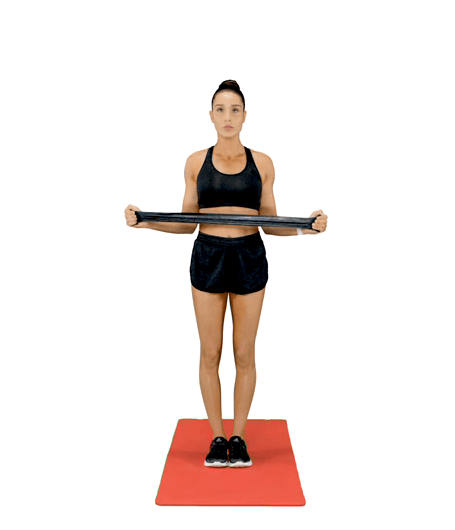
Internal shoulder rotation:
- Hold the wand or exercise band with the hand that belongs to the affected arm. Keep your elbows at a 90-degree angle and pull the wand or band towards your body, holding it for 5 seconds. Do this once a day for 10 to 15 repetitions.
Shoulder Abduction:
- Grasp the bar or band in front of the chest, extending the affected arm at a 90-degree angle for 10 to 15 repetitions.

Pendulum Exercise:
- Bend over at the waist so that the arm falls away from the body and moves in a relaxed way. Use your body to initiate a circular motion.
- Make small circles while keeping the shoulder relaxed Do this for 2 to 3 minutes at a time.
- Perform the same exercise again by gradually adding weight.
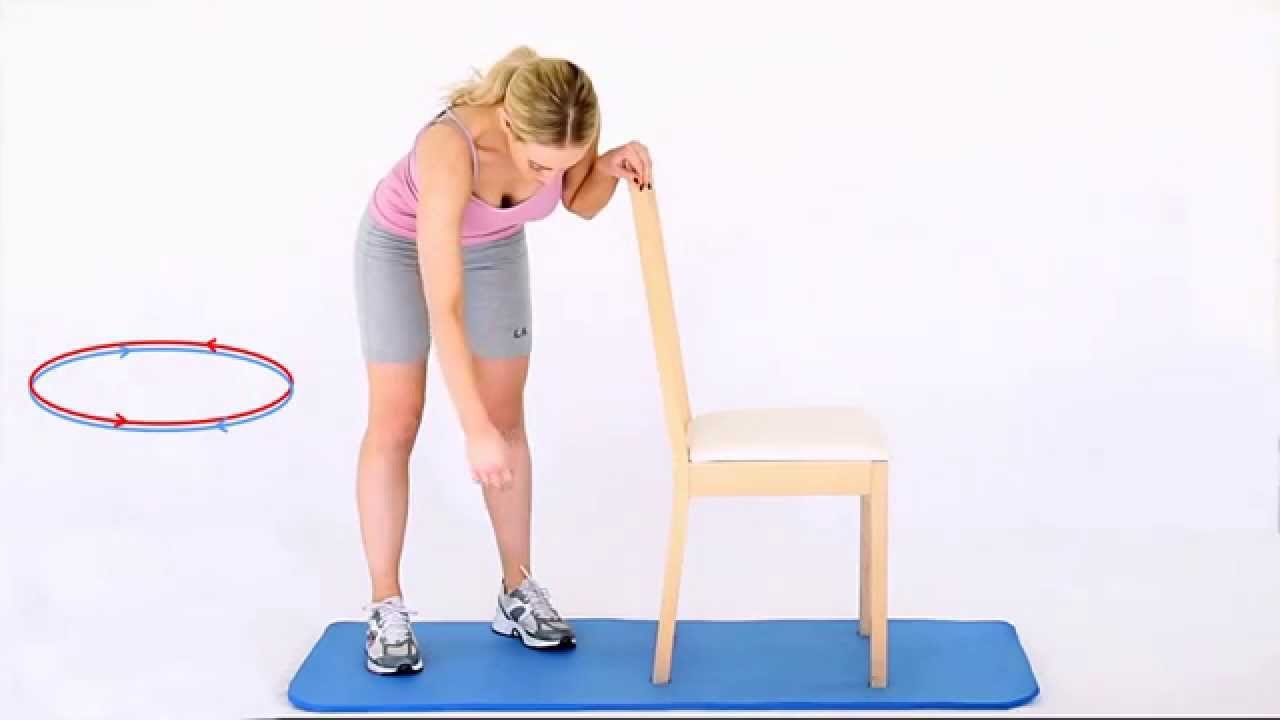
Wall Climbing:
- Wall Climb Stretch Stand facing a wall, place the hand of the affected arm on the wall. Slide the hand up the wall, allowing the hand and arm to go upward. As you are able to stretch the hand and arm higher, you should move your body closer to the wall.
- Hold this stretched position for a few seconds, return to the starting position and perform 10 repetitions.
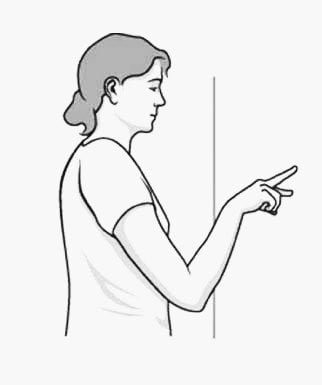
Towel Stretch:
- Hold the towel in both hands along with your back.
- Gently pull the towel with your unaffected hand to draw the affected hand upwards.
- You will feel a slight stretch in the shoulder joint as the affected hand is pulled up against your back.
- Ensure that no pain is experienced during the stretch.
- Hold for a few seconds, relax, and repeat again.
- Now perform the same exercise with alternate hand placement and do 10 repetitions.
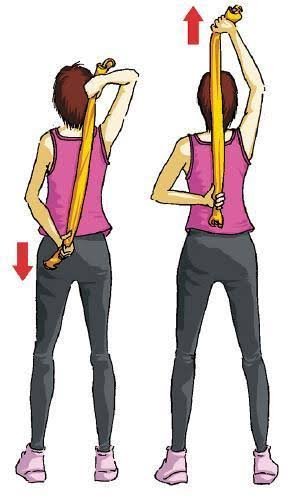
Cross Body and Deltoid Stretch:
- Stand straight.
- While using your unaffected arm, hold the affected arm at the elbow, and bring it up and across your body towards the unaffected side, by gently applying stretch to the end range.
- Hold this stretch for a few seconds and perform 10-15 repetitions.

Outward Pulling:
- Stand straight while holding a rubber band in both of your hands with the elbows of both arms bent at 90 degrees along with your body’s sides.
- Keeping the unaffected arm still, pull the rubber band outward with your affected hand and hold the stretch for 5 to 10 seconds.
- Perform 15 to 20 repetitions daily.

Inward Pulling:
- Stand next to the closed door with a knob on the door.
- Knot one end of a rubber band around the doorknob, while with the hand of the affected arm, bending the elbow at 90 degrees, holding the other end of the rubber band.
- Pull the band towards your body and hold the stretch for 10-20 seconds, release the band and repeat again.
- Perform 15-20 repetitions daily.
Axillary Stretch:
- Using your good arm, lift the affected arm onto a shelf at the level of breast height. Gently bend your knees, opening up the armpit.
- Deepen your knee bend slightly, gently stretching the armpit, and then straighten the knees. With each knee bend, stretch a little further, but don’t force it. Do this 10 to 20 times each day.

Wand Exercise:
- Lie straight on the floor. Hold a stick at each end with both of your hands. Your palms should be facing down while holding the stick.
- Hold the stick with both ends using both hands in such a way that your hands are a bit wider than your shoulder width.
- Keeping both elbows straight, slowly raise your arms above your head until you feel a stretch in your shoulders, upper back, and chest.
- Hold for 15-30 seconds. Repeat 2 to 4 times.
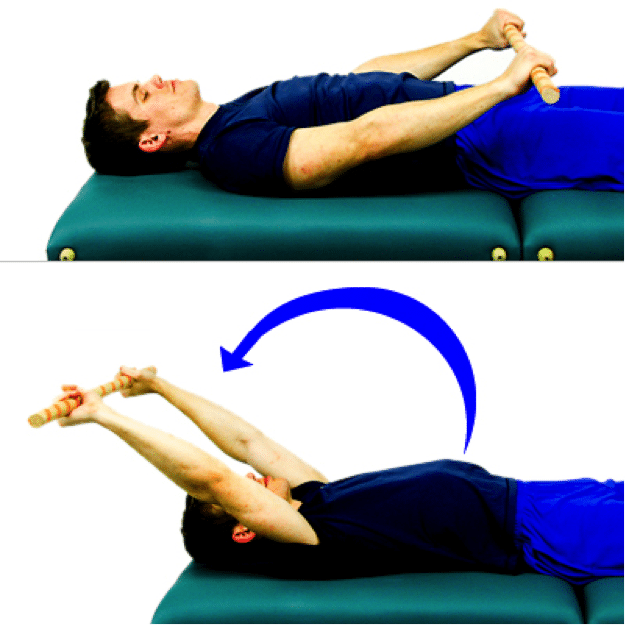
Squeezing Scapula:
- While standing with your arms at your sides, squeeze your shoulder blades together. Do not raise your shoulders up as you are squeezing.
- Hold for 6 seconds. Repeat 8 to 12 times.

Shoulder Rotation:
- Lie straight on the ground, and keep your legs straight. Hold a stick in both hands keeping the elbows flexed and palms upwards towards the ceiling.
- Keeping the elbows close to the body, move the wand across the body to the aching arm.
- Hold for 15-30 seconds. Repeat 2-4 times.
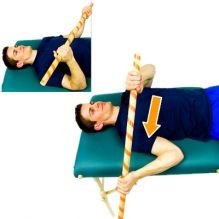
Bicep Stretch:
- Stand in front of a wall, about an arm’s length away from it.
- Raise one arm to the side placing the thumb side against the wall with your palm facing down.
- Keeping the elbow straight, rotate your body in the opposite direction of the arm until you feel the stretch across your bicep.
- Hold for 15 seconds, then repeat 3 times.

Shoulder Shrugging:
- Seated in a comfortable position.
- Keep both arms on each side of the body.
- Gently move your shoulders upwards and hold the position for 10 seconds.
- Bring back to the resting position, and repeat again.
- Perform 10-20 repetitions daily to regain joint mobility.
| You may also like to read: |
Massage Techniques:
You can use different massage techniques to relieve shoulder pain and stiffness.
- FOAM ROLLER can be placed in the underarm area while in a side-lying position. Gently move your body back and forth on a foam roller placed in the underarm area.
- THE SELF-MASSAGE technique is simple and easy to do by yourself. Sit in a comfortable position. Using the unaffected hand, massage the shoulder region of the affected side. Slowly move the affected shoulder while doing a massage.
- ELECTRONIC MESSAGE is a quick and easy technique to relieve shoulder stiffness and increase muscle flexibility and movement.
| You may also like to read: |




